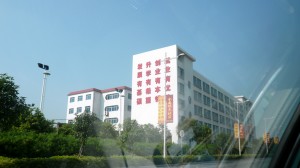The story of China’s growth has been the story of its workers. Long discussed in regards to China’s meteoric rise, the millions of blue-collar, migrant workers upon which the bulk of the nation’s productivity has been based have come from the vast swaths of rural China to the coastal factories to work. Described as an “army” of readily available cheap labor, they have long fulfilled the burgeoning needs of the world’s largest export-driven economy (discounting the European Union).

This narrative of China’s workers is one we’ve been hearing for a long time, which doesn’t make it any less true—cheap labor, together with investment, has been the driving force behind China’s ascendancy to economic power. But now there exists a new dynamic, and one that has been nearly non-existent until the present. It is the story of China’s consumers.
Back in March, I had the pleasure of hearing Min Zhu, the deputy Managing Director of the IMF, give a talk at the Watson Institute, titled “A Changing China in a Changing World.” He said a great many insightful things, but one in particular still stands out: his description of Chinese consumers as being an integral part of the nation’s future development. He is not alone in his analysis—the Chinese government’s Twelfth Five Year Plan (or Twelfth Guideline, as it is now known), a development initiative for the years 2011 to 2015, includes boosting domestic consumption among its key goals. Many attributed China’s lackluster (for them) growth target of 7.5% in 2012 to the nation’s over-reliance on export-driven growth and superflous investment.
The Chinese have, historically, had these astronomically high levels of savings. Min Zhu pointed to government policy as one reason for such high savings levels among the Chinese—for another possible explanation, check out this fascinating Ted Talk. Whether because of political, social, or cultural factors (or a combination of all three), the fact is that Chinese savings (and investment) levels have been at or near the world’s highest for quite some time.

All this seems to be changing. There is a growing, consuming working class in China, separate from their parents and their grandparents in their ability and, a little bit less certain, their desire to consume. In 2011, consumption surpassed investment as a total share of economic output, (even this figure could be higher) and such a phenomenon represents a dramatic turning point for the Chinese economy and reveals changes in the Chinese migrant labor market, whose members spent 4.2 trillion Renminbi last year, or $680 billion (see the China Confidential survey). Wages for workers in the Pearl River Delta, a major manufacturing region, are up 10% and likely expected to increase, further fueling consuming habits.
What stands in the way of Chinese consumption? Income inequality, to start. Though wages may be up, there is no way around income disparity. With a GINI index of 47.4, (between Madagascar and the Dominican Republic on a the world list,) inequality in China is a glaring problem, enough so that the government seems to be making moves to alleviate the issue. Another challenge is brand recognition. In most cases, foreign products still reign supreme in this area, an occurrence that will need to change if China wishes to establish a bond between domestic manufacturing and consumption.
For many years the saving patterns of the Chinese have fueled growth at home and consumption abroad, particularly here in the United States, in the form of ridiculously high trade deficits. However, as western countries including the United States stand on the ever-thin ice of a post-2008 world, it is time for the Chinese to turn inwards for growth, to an increasingly more reliable source of demand: themselves, the millions upon millions of people who, now with a few extra dollars in their pockets, just might decide to spend.
